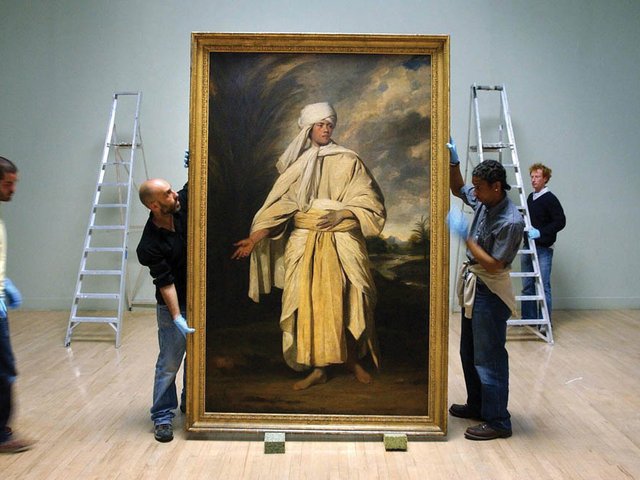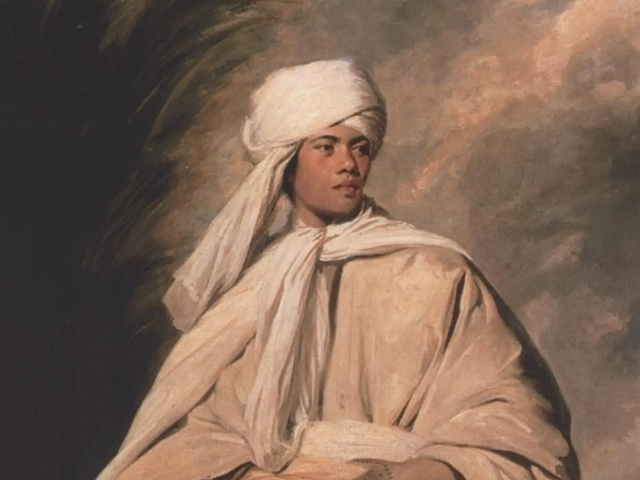Britain’s two major galleries are both trying to raise massive sums to save masterpieces threatened with export, Raphael’s “Madonna of the pinks” and Reynolds’s portrait of Omai.
To add to the complications, The Art Newspaper has learned than London’s National Portrait Gallery (NPG) may soon face the challenge of trying to buy William Parry’s portrait of Sir Joseph Banks with Omai and Dr Solander.
It is a curious coincidence that two portraits of the young Tahitian Omai should have come onto the market at almost the same moment, but they are very different works. “The Parry is important for the story it tells, and the Reynolds for what it represents about British art of the 18th century,” explained Lucy Peltz, NPG curator.
The Parry portrait had been sold two years ago to an anonymous overseas buyer, which we can name as the Australian National Portrait Gallery. The price agreed was £1.8 million ($2.9 million) and a UK export licence was deferred.
Despite being turned down by the Heritage Lottery Fund (HLF), London’s NPG and its partner, Whitby’s Captain Cook Memorial Museum, succeeded in raising two-thirds of the money from other sources, but not quite enough to buy the picture. However, the export licence application was subsequently withdrawn, because the Australian National Portrait Gallery had to pull out of the sale. It too had unexpectedly found itself unable to raise all the necessary funds. The Parry portrait remains on loan to the NPG in London, and it is likely that it will shortly be offered for sale again.
Meanwhile, an export licence for the Reynolds portrait of Omai has been deferred until 17 March, and this period will almost certainly be extended until 17 September to enable Tate to attempt to raise the necessary funds.
A six-month second deferral period is exceptional, but this is because of the owner’s refusal to allow the work to go on display at the Tate during the fundraising campaign. The Reynolds is currently languishing in a south London store, and last month a request by The Art Newspaper to view the picture was rejected by the owner.
The price which Tate will have to match is £12.5 million ($20.3 million), representing the sale price of the Reynolds after its purchase by London dealer Guy Morrison at Sotheby’s on 29 November 2001. There have been reports that the ultimate overseas buyer may be Dublin collector John Magnier, although the export licence has been applied for in the name of a Swiss company, Settlements.
Before the auction, Tate had tried to buy the Reynolds in a £5.5 million (£8.9 million) private treaty sale which would have had tax advantages for the original seller, Simon Howard of Castle Howard.
In November 2001, just before the Sotheby’s sale, HLF had approved a £900,000 ($1.5 million) grant, but this could not be taken up when the picture sold at auction.
Tate will very shortly be applying to HLF for around £9 million ($14.6 million). In principle, HLF presumably still favours the painting, but the question is whether it will be able to increase its grant ten-fold.
The National Gallery’s application to HLF for Raphael’s “Madonna of the pinks” was submitted on 10 January, for £20 million ($32.5 million). An export licence was then deferred on 27 January, initially for one month, but this is virtually certain to be extended until 27 August, again an unusually long second period.
Although the Getty Museum has bought the Raphael for £34.9 million ($56.8 million), the cost to the National Gallery would be £29.5 million ($48 million) because of the tax advantages of a private treaty sale. Even if HLF approves the full application, this would still leave £9.5 million ($15.5 million) to be raised, which could only be found if the gallery dips deep into the endowment provided by Sir Paul Getty.
Both the Reynolds and the Raphael are expected to be considered at HLF’s meeting in July. Last year it awarded a total of £15 million ($24.4 million) for all art acquisitions, so dealing with two applications for nearly twice this sum will be difficult.
Although HLF has an unspent balance totalling £1 billion ($1.6 billion), this is committed for agreed projects and it would be difficult to divert any of this to new art acquisitions.
Meanwhile, two important Michelangelo drawings have now left the UK. “Study of a mourning woman”, from Castle Howard, was sold to a US private collector by dealer Luca Baroni for £7.5 million ($12.2 million). It is believed to have gone to America last month.
“The risen Christ”, owned by the late Sir Brinsley Ford, was also sold to a US collector, going through dealer Katrin Bellinger for £8.2 million ($13.3 million); it left the UK last year. Although the National Gallery of Scotland was interested in buying either of the Michelangelos, it failed to raise the necessary funds.
Readers of The Art Newspaper have voted by internet that they would rather save both the Raphael and the Reynolds paintings at present threatened with export, but, forced to choose between them, Reynolds was preferred. The full results are: those who want to save both (33%); those who would choose Reynolds (30%); those who would save the Raphael (21%); those who would choose neither (9%). Those who would save Reynolds’s portrait of Omai were eloquently represented by a prominent American scholar and curator who wrote: “Were the Raphael to leave the UK it would at least be going to a public institution [the Getty] where it would be generally accessible. On the other hand, recent news items indicate that the new owner of the Reynolds would make it unavailable.” Those who would save the Raphael simply pointed out its quality; one reader called it “one of the best paintings in Europe.” Those who would not save either had strong arguments: “With £40 million we could plug more serious gaps in the national collections”



